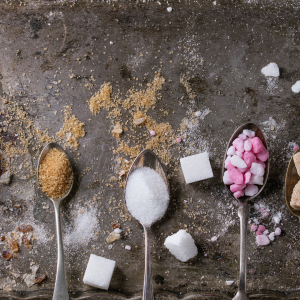How To Eat Less Sugar: Replacing Sugar Alcohols

Its probably not going to come as a surprise to you that eating more whole and fresh foods in their least processed form appears to yield greater health benefits than eating a diet composed mainly of processed, packaged and pre-made foods. What may surprise you is the reason behind it and some research suggests it has to do in part to a specific sugar alcohol: erythritol.
What is Erythritol?
- a man-made compound that chemically acts like sugar in terms of sweetness but does not raise blood sugar
- it is not calorie free
- ingesting 10-15 grams of it/day is recognized as a safe
The Link Between Erythritol and Heart Attack and Stroke
A recent study conducted by the Cleveland Clinic included 1,000 people who ingested erythritol and followed them for 3 years. Results from that study suggested a link between erythritol levels in the blood and increased risk for future heart attack and stroke. People in the study who had the highest percent of erythritol were two times as likely to have a cardiac event as those with the lowest amounts in their blood. In mice, they found that erythritol presence in the blood increased blood clot formation and platelet changes.
What Foods Contain Erythritol?
Many foods found in the grocery store contain erythritol. It is commonly used in candy, gum, protein shakes, electrolyte drinks, and icecream. That are marketed to people following a low-carb diet (think keto- or diabetes-friendly). Food companies are not required to list its presence on a food label unless they make a health claim about it. You can find erythritol by locating it listed as "erythritol" the ingredient list on the back of a product underneath the Nutrition Facts label.
What Sweeteners Should I look for In Place of Erythritol?
This is a tough one. Sugar -- and eating it in excess (defined as more than 6 teaspoons or 24 grams/day) appears to be associated with harmful inflammation and an increased likelihood of cardiovascular events. And because sugar comes in various forms: fructose, maltose, dextrose to name a few. Knowing where to find it and what to do in place of it can be confusing. We recommend that you:
- Look for "Added Sugars" on a food label and minimize this as much as possible. That way you aren't getting too hyperfocused about the natural sugar in your applesauce or the lactose in your milk.
- Opt to purchase and eat foods with recognizable ingredients in the ingredient list: honey, cane sugar, agave, maple syrup.
- Avoid foods sweetened with "high fructose corn syrup"
It generally takes a person some time to adjust to a lower-sugar eating pattern (similar to the time it takes someone to become adjusted to a low-salt diet). So expect to have some intentional substitutions to high sugar foods when a craving hits like:
- berries
- melon
- dried dates
- water flavored with citrus
- grapefruit

 RSS Feed
RSS Feed